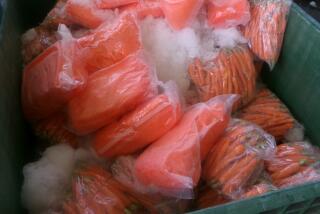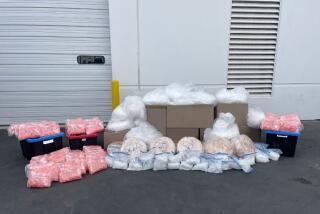In North Korea, meth is offered as casually as a cup of tea
After the North Korean coal mine where she worked stopped paying salaries, Park Kyung Ok tried her hand at business.
Buttons and zippers, candy and dried squid, fabric, plastic tarpaulins, men’s suits and cigarettes.
“I sold just about everything,” said Park, 44.
But it wasn’t until she started hawking methamphetamine in 2007, she said, that she was able to earn a living.
Methamphetamine, known as orum, or “ice,” is a rare commodity manufactured and sold in North Korea, where most factories sit idle, the equipment rusted or looted. The North Korean government once produced the drug, and others that are illicit in the West. Resourceful entrepreneurs have since set up their own small facilities, and evidence suggests that they are distributing the drug beyond the nation’s borders.
Last month, five alleged drug smugglers — Chinese, British and Thai men among them — appeared in federal court in New York, extradited from Thailand in a plot to smuggle 220 pounds of crystal meth to the United States. They said that their product originated in North Korea.
A Harvard University researcher, Sheena Chestnut Greitens, has tracked 16 drug busts from 2008 to the present in China involving crystal meth from North Korea in quantities of up to 22 pounds.
“Meth is a product you can make in bathtubs or trailers,” Greitens said. “You have a wide range of people involved in production and trafficking.”
Park, a bantam-size woman who tittered nervously when recounting her own audacity, said she got into the meth business fresh from a divorce, while struggling to support her children and a disabled sister in Hoeryong, a hardscrabble mining town of 130,000 on the Chinese border.
Park used to travel to another North Korean city, Chongjin, to buy meth that she would carry back hidden in a candy box. She would sell it behind the counter at a bicycle parts store at the public market. Hidden among the spare parts were metal plates, burners and other drug paraphernalia.
She usually paid the equivalent of $15 for a gram of high quality product, which she would then cut with cheaper meth and divide into 12 smaller portions to resell for a few dollars’ profit.
“It was just enough money that I could buy rice to eat and coal for heating,” said Park, who was interviewed recently in China and, like most North Korean defectors, used an assumed name.
North Koreans say there is little stigma attached to meth use. Some take it to treat colds or boost their energy; students take it to work late. The drug also helps curb appetites in a country where food is scarce. It is offered up as casually as a cup of tea, North Koreans say.
“If you go to somebody’s house it is a polite way to greet somebody by offering them a sniff,” said Lee Saera, 43, of Hoeryong, also interviewed in China. “It is like drinking coffee when you’re sleepy, but ice is so much better.”
Despite its draconian legal system, North Korea has long been easygoing about narcotics use. With analgesics scarce, opium paste is commonly sold for pain relief. Marijuana (called “mouth tobacco”) is legal and frequently grown at home to be mixed in with rolling tobacco.
Methamphetamine is a synthetic drug that was first developed in Japan in the late 19th century, made from chemicals such as ephedrine and distributed as a stimulant.
Through the 1990s, the North Korean government ran the production of opium, meth and other drugs for Office 39, a unit raising hard currency for late leader Kim Jong Il, according to narcotics investigators. But the North Korean government has largely gone out of the drug business, according to the U.S. State Department’s 2013 International Narcotics Control Strategy Report.
When the North Korean government controlled the business, the drugs were strictly for export. Privatization made the drugs more widely available within North Korea. North Koreans say meth first appeared on the streets around 2005 and that it came from Hamhung, the onetime center of the nation’s pharmaceutical and chemical industry, and thus a city filled with unemployed scientists and technicians. The industry then spread to Chongjin and the capital, Pyongyang.
“North Korean people learn fast to reuse their skills,” said Kim Yong Chol, 58, a truck driver who fled North Korea in August.
Meth was ideal for budding North Korean entrepreneurs because it could be cooked in small “kitchen laboratories,” with chemical precursors readily available across the border in China, which has laxer control than many other countries.
The finished product finds its way back across the border, carried by smugglers who also traffic in cellphones, DVDs and cash.
Sensitive about their traditional political ties with the communist country, the Chinese don’t often complain publicly about North Korean drugs and Chinese news reports do not mention the neighboring nation. “The stories would often say they arrested somebody named Kim from the border of a foreign country, so you could figure it out,” Greitens said.
In Yanji, a Chinese border city of 400,000, the number of drug users increased nearly 47 times from 1995 to 2005, according to a paper published in 2010 by Cui Junyong, a professor at the Yanbian University School of Law in China.
“Smuggling of North Korean drugs into China hurts the health of the province and the region and endangers the stability of the region,” Cui wrote.
The case in a New York court last month involved a gang reportedly working out of Thailand and the Philippines. The drugs never reached the United States, but samples provided to undercover agents proved to be 99% pure, according to the indictment filed in U.S. District Court in New York.
Those arrested said they were the only remaining providers from North Korea.
“The NK government already burned all the labs. Only our labs are not closed,” a Chinese citizen who was one of the gang reportedly boasted to an undercover Drug Enforcement Administration agent.
Because of the purity of the meth seized by the DEA, experts believe it might have been stockpiled and left over from the days when the North Korean government ran the drug manufacturing. The drugs produced by private entrepreneurs are of lower quality, according to Greitens.
It is unclear how serious the North Korean government is about cracking down on the drug trade, or if it is merely trying to reassert control over a lucrative business. Lee, released in 2011 from a North Korean labor camp where she was sentenced for illegal border crossing, said that of 1,200 inmates, up to 40% had been arrested for trafficking meth.
Park, the self-described former dealer from Hoeryong, said, “If you are caught once or twice, with only a small amount like me, you can get away with it if you have connections. But a third time, you will be in real trouble.”
She said she soured on the meth trade after a few years. In her inminban, the neighborhood committee by which North Korean society is organized, there were two or three people who were serious meth addicts.
“Mostly men, they would get crazy and fight with knives,” Park said.
She was distraught when her teenage daughter admitted she sniffed meth to concentrate on her studies.
“I was doing bad things because everybody else was doing bad things,” Park said.
She quit the meth trade in 2009, she said, and left North Korea the following year in hopes of rebuilding her life.
imes.com”>barbara.demick@latimes.com
More to Read
Start your day right
Sign up for Essential California for news, features and recommendations from the L.A. Times and beyond in your inbox six days a week.
You may occasionally receive promotional content from the Los Angeles Times.






